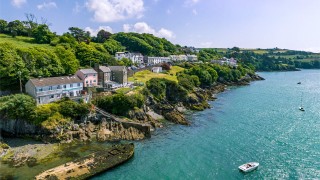
Glandore, Union Hall & Leap
The entrance to Glandore Harbour is guarded by two rocky islands, Adam and Eve. The advice to sailors navigating in the harbour is ‘Avoid Adam and Hug Eve’, a lesson first taught, no doubt, by sad experience on Adam’s reefs and shoals.
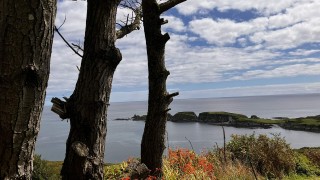
Directions
Located on the R597, 72km west of Cork city, 20km from Clonakilty.
Special Areas of Conservation
Myross Wood.
Glandore is to the starboard as you enter the bay and Union Hall is to the port side. By road, the villages are connected by a unique one-lane Poulgorm Bridge used famously as the set location for the production of David Puttnam’s Irish film the ‘War of the Buttons’.
Pretty coastal villages steeped in history, Glandore and Union Hall’s position in the path of the Gulf Stream ensures a mild climate all year round. They also have the advantage of being both seaside and country. With activities like sailing, swimming, fishing, walking, snorkelling, picknicking and much more, you’ll definitely be kept busy.
The summer season brings many visitors and enthusiasts getting involved in water sport activities such as the sailing course. Perhaps you may be lucky enough to catch a glimpse of the odd dolphin or seal on your visit. Every second year Glandore hosts the Classic boat regatta in mid July – a popular event which finishes in a grand display of fireworks. The annual regatta takes place the third weekend of August.
Information courtesy of www.glandorevillage.ie
VILLAGES NEARBY: Leap
At the northern extremities of Glandore Harbour lies the village of Leap (pronounced as ‘Lep’). Leim Ui Dhonnabhain (Gaelic) derives from an ancient story of a local Chieftain O’Donovan, who while being pursued by enemies jumped the ravine and escaped, thus O’Donovan’s Leap. To the west of the village, on the Skibbereen road, are the Shepperton Lakes, picturesquely set beneath the hills. These are very popular trout and fishing waters. Ballinlough Lake lies to the north.
Discover the Locality
History
Glandore and Union Hall are some of West Cork’s earliest settlements due to their location. Scattered around the area are the remains of Bronze Age forts (locally known as fairy forts), which date from 600AD.
Legend has it that there is gold buried between the two 11th century Norman castles in Glandore. Although now privately owned you can see these from Glandore Bay if you happen to be out sailing or swimming or they can be glimpsed from Glandore Pier. Glandore was then for centuries closely associated with the O’Donovan family, who gained control of the harbour from the Normans and occupied its castles.
The ruins of two O’Donovan castles can still be seen. Castle Eyre or Ivor is close to Union Hall on the edge of a rocky mound overlooking Lake Cluhir. It was built around 1250. Unfortunately there is not much remaining of the building except a portion of a small tower and some walls. Raheen Castle, situated on the east bank of Glandore Harbour on the opposite side to Castletownsend, was built circa 1580. The walls were severely damaged during a Cromwellian naval attack and cannon balls can be seen embedded in the wall.
The present pier and wall at Glandore were built in the first half of the 19th century.
Drombeg Stone Circle
The area is most well known for Glandore’s Drombeg Stone Circle, which dates back to approx. 1000BC and is just a 25 minute walk from Glandore village (3km).
One of the finest examples of a Bronze age stone circle, Drombeg consists of 17 standing stones, the highest, forming the entrance to the circle, the others tapering down in height to the altar-like axial stone opposite, which, in this case, has two cup marks. During the winter solstice, the sun’s rays fall on this stone.
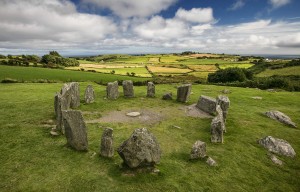
Adjacent to the circle is an ancient cooking pit or ‘Fulacht Fiadh’. This prehistoric kitchen had a flagged trough in which water was boiled by dropping red-hot stones into it. Recent tests confirmed that using this method, 70 or more gallons of water could be boiled for almost three hours.
Evidence suggests that Drombeg was more than a temporary seasonal hunting encampment and was used more as a ritual site where many people would gather.
The site was excavated and restored in 1958. During this process a pot was found in the centre of the circle, containing the cremated remains of a young adolescent wrapped with thick cloth. Radiocarbon dating of samples taken from the site suggest that it was active c. 945 – 830 BC. The pot was buried near the centre of the circle along with 80 other smashed shards, four bits of shale and a collection of sweepings from a pyre.
To reach the site, pass the Marine Hotel, go through the village past St. Facthna’s Church and take a sign posted right to the Stone Circle.
Coppinger’s Court
After the Battle of Kinsale in 1601 the Irish chieftains of West Cork – O’Driscoll, O’Mahony, O’Donovan and O’Sullivan being the four strongest, lost most of their territory. Sir Walter Coppinger, a Cork merchant of Viking ancestry, acquired much of the O’Driscoll territory on the both sides of the Ilen River and a great deal of land near Rosscarbery. In the early 17 th century he built a manor house halfway between Rosscarbery and Glandore called ‘Coppinger’s Court’.
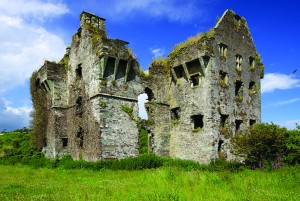
This was the largest house in Carbery and the popular belief was that it had a chimney for every month, a door for every week and a window for every day of the year. There was a big lawn in the front of the house with silver gates at the entrance. The Coppingers took the losing Royalist side in the wars of the 1640’s. In 1641 the house was attached, ransacked, partially burned and left in ruins. Legend has it the gates were then taken to Lough Avrickeen – a small lake about half a mile south-east of the new church in Glandore – where they were thrown and still lie.
The Glandore Submarine
Towards the end of World War II, a German submarine, U – 260, was travelling approximately 20 miles south of the Fastnet Lighthouse. What it was doing there is uncertain but there was speculation it was involved in an espionage liaison.
The submarine was struck by a mine on 12th March 1945 and the Commander, Captain Klaus Becker, headed for the Irish coast, intending to make repairs. However, such was the extent of the damage, it became unmanageable and surfaced. Becker kept his vessel afloat by running the exhaust gases form the diesel engines into the ruptured ballast tanks. Finally, orders came by radio from Germany to scuttle U – 260.
The crew of three officers and 42 men boarded rafts and one-man dinghies called ‘cockle-shells’. Two crewmembers came ashore at Galley Head and raised the alarm with the lighthouse keeper. The Courtmacsherry lifeboat was launched and the remaining crew were brought safely ashore. They were arrested and interned at the Curragh Camp, Kildare until the end of the war.
Local fisherman Colin Barnes discovered the wreck site of U-260 in 1975 after snagging nets, although it was presumed that the wreck of the Counsellor (sunk due to a mine in 1917) was in the area. A friend of Mr Barnes, Joe Barry, dived on the noted position and discovered the U-boat rather than the expected cargo ship.
U-260 currently lies in about 45 metres of water, approximately four miles south of Glandore, and is a popular scuba diving site.
Glandore Mines
Glandore mines are located in the townland of Aughatubrid – on the side of a small hill between Glandore harbour and the village of Leap. A well preserved (albeit heavily overgrown) engine house with an intact chimney remain.
The mines were worked from 1810-1820 for the production of copper. Copper was obtained by burning copper rich peat from Maulagow bog below the mine. Subsequently the mines were worked for manganese, which was exported to Liverpool. The mines closed in 1881, and were reopened in 1907 when manganese prices rose. Unfortunately higher costs made it unprofitable and the mines finally closed in 1911.
Things to do
Sailing
Such is Glandore’s long association with sailing that the village hosted West Cork’s first regatta in 1830.
Glandore is a perfect amphitheatre for sailing as its elevated position makes for great spectator viewing. Glandore Harbour Yacht Club hosts several sailing events throughout the season and provides sailing instruction for the local schools and junior sailors.
The club is home to a fleet of Dragons and Squibs, which provide the main sailing competitions during the summer months. The bi-annual Classic Boat Regatta is held in July and attracts many overseas visitors to the village.
The scenery around the bay is very picturesque and is both spacious and secure offering good anchorage. The islands of Adam and Eve protect the harbour, so you are truly in the Garden of Eden.
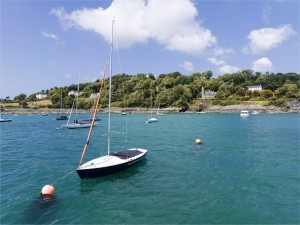
Village Walks
There are a number of pleasant and scenic walks around Union Hall and Glandore, both coastal and inland. See Glandore & Union Hall Walks under the Walking section.



